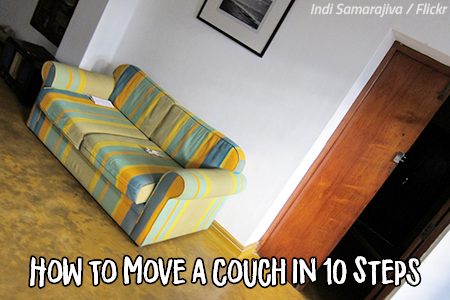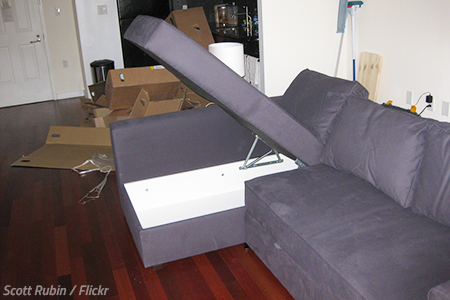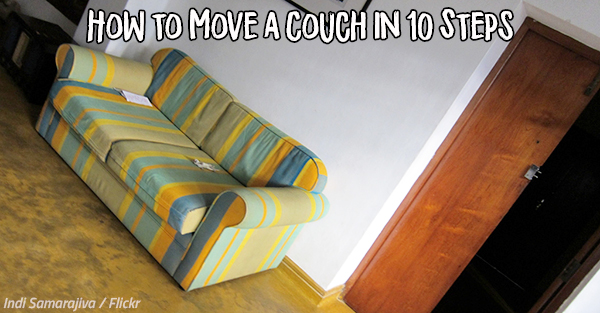 Moving a large and heavy couch to another home doesn’t sound like an easy thing to do, and in most cases, it isn’t. In fact, there are a number of must-do steps to moving a couch you must follow to finish the job quickly, and more importantly – safely.
Moving a large and heavy couch to another home doesn’t sound like an easy thing to do, and in most cases, it isn’t. In fact, there are a number of must-do steps to moving a couch you must follow to finish the job quickly, and more importantly – safely.
The couch moving challenges for you will range from having to decide whether to move your sofa at all to how to protect and move the heavy furniture piece without causing any damage to it or to the property you’re leaving. How to avoid injuries when moving the couch is also something you must seriously consider beforehand.
Here are the 10 steps to moving a couch the way it is supposed to be moved – with zero risks for you, your helpers, the home and the furniture piece itself.
Step 1: Ask the big question: Is it worth it?
Large furniture pieces are rarely worth the trouble and, more importantly – the expenses to be moved between two homes. Why? Most of those furniture items are rather heavy, which automatically means higher transportation costs because professional movers calculate the moving price based on the total shipment weight.
So, while packing and moving a few more books won’t make any noticeable change in how much you pay your movers in the end, packing a moving even one extra furniture piece – like your sectional sofa or sleeper sofa, for example – will make a big difference price-wise.
This is why the very first step when moving a couch across country is to determine whether or not you should move your furniture piece at all. To help you make that important decision, you may as well as yourself these couple of questions:
1) Value. Is your couch valuable? Is a good-quality one manufactured by a famous brand? Is a gift from a special person? Do you feel any sentimental attachment to it? How much did you pay for it in the first place?
2) Condition. Is your couch in a good overall condition? Is it lightly-used, or is it old and worn-out? Won’t it be easier and cheaper to just buy a new one after the move?
How to get rid of unwanted items when moving
Step 2: Measure your couch to avoid trouble
The second step to moving a couch out of an apartment or a house is to make sure you won’t run into trouble the moment you start moving the furniture in the direction of the door. Trouble? What trouble?
Your large couch may prove to be too big for the small doorway and won’t fir through it as a result. What about getting stuck into a narrow corridor? Oops!
To avoid such a frustrating moment, you’re going to have to know how to measure a couch for moving:
- MEASURE the dimensions of your sofa – use a measuring tape to determine its actual height, width, and length;
- MEASURE all doorways, corridors, and staircases along the planned exit path;
- COMPARE the measurements to figure out if you’re likely to have any couch moving problems, or not.
If you sense trouble ahead after taking a closer look at the measurements, then the next step should be to disassemble the couch, partially or completely.
Step 3: Disassemble your couch for moving
If it turns out that your sofa is too big to fit through a door, then you won’t have much of a choice than to take apart the couch for moving. Once you remove all detachable parts from the big furniture piece, you’ll be able to move it more easily and safely, thus preventing possible property damage or personal injury in the process.
How to disassemble a couch for moving? Follow these very steps to do so:
-

Consider disassembling your couch to make things easier and safer for yourself.
REMOVE cushions, covers or anything else that is on the sofa at that moment;
- REMOVE the legs of the sofa by unscrewing the screws that hold them from the main frame of your furniture piece. Sometimes you may need to just turn the legs anticlockwise to take them apart;
- TAKE OFF the armrests or any other couch elements that can be safely taken apart without causing damage of any sort;
- KEEP screws and other metal or non-metal fastening parts in a sealable plastic bag or a compact container with a tight lid;
- GET qualified help if you encounter any difficulties or run into any problems while disassembling your sofa for a move.
The best packing tips when moving
Step 4: Pack your couch for moving
One thing is clear – your couch will need to be protected during the move so that it does not sustain any sort of damage that will be too costly or maybe even impossible to fix after the move. And since you’ve decided to pay to take that furniture piece with you, then you must value it as a must-have item.
How to wrap a couch for moving?
- WRAP each disassembled element in thick furniture blankets to keep them protected. If any of the elements is too fragile, then use packing paper as an initial layer, then wrap up that part in bubble wrap to avoid any possible damage;
- TRANSFER the disengaged couch parts into a separate cardboard box, then label that box for easier post-move identification;
- PACK with packing paper and then bubble wrap any protruding couch elements that are still on its main structure and run the risk of being damaged during the move.
- PLACE cardboard cut-outs over the corners or delicate areas of the couch, then use tape to fix those pieces of thick cardboard.
- CONSIDER wrapping your entire couch in shrink wrap to keep dust, dirt, and moisture away, especially if that sofa is very expensive, or very valuable, or both.
- WRAP thick furniture blankets along the entire length of the couch as the final layer of protection. Tape those protective coverings to keep them in place.
How to protect furniture when moving
Step 5: Get proper couch moving equipment
Most couches are too big and too heavy to be just lifted and carried out of your home without any problems whatsoever. So, even if you’ve secured the assistance of several loyal (and strong!) friends – see the next step – you may still want to have a few moving equipment pieces on hand to make the entire furniture moving task easier on everyone. And safer too.
To protect a couch when moving, to prevent property damage, and to avoid personal injuries, you have to have the following moving equipment:
- Furniture sliders. Furniture sliders are pieces of durable plastic and hard rubber on one side that, when placed under the legs or sides of your couch, will let you slide the heavy furniture piece easily across the floor without causing any type of damage to the floor surface. The main goal of furniture sliders is to minimize friction while you push the sofa from its resting place to the room door or even until the front door of your residence. Get such sliders from a local mover or from a local home improvement store.
- A furniture dolly. Even if you’ve secured the help of your friends on the day of the move, moving a couch with a dolly is the proper thing to do, especially if your sofa is too big and heavy. A furniture dolly is a 4-wheel platform that sits low on the ground that will make your couch moving task a lot easier and safer. Again, you can get that type of moving dolly from a local moving company.
Step 6: Ask friends to help you move the couch
Moving a couch by your yourself – in the sense of you doing it entirely on your own – is a bad idea that can lead to all sorts of trouble. Do NOT attempt to move your couch without any helpers around – it’s very risky dangerous even with the right type of dolly as positioning the big furniture onto the wheeled platform will be next to impossible.

When moving a BIG couch, every helper makes a BIG difference.
The easiest way to move a heavy couch is to pay experienced furniture movers to do it for you – you just stand aside, with no risks of personal injury, and watch the pros do what they do best. But if that is not a viable option for you, then you must reach out to your good friends and ask them to help you move your huge couch.
In most cases, you’re going to need at least two helpers to move a couch safely. However, if the furniture piece is neither too heavy nor too large, you may get it done with only one friend by your side.
How to get friends to help you move
Step 7: Follow the safety tips for moving a couch
When moving heavy furniture, safety should become the number one priority and concern for everyone involved in the move. And when moving a couch to another home, things should remain the same as your sofa is a classic example of a heavy furniture item.
To eliminate the risk of personal injuries or property damage, implement the following safety measures on the day of the move:
- DON’T move your couch entirely on your own. Ask a couple of reliable friends to give you a hand.
- CHECK whether the exit path of the heavy furniture is perfectly clear – no obstacles of any kind, especially randomly scattered boxes, should be present along the route out of your home. Also, look for and eliminate any wet, dusty or muddy spots along the way.
- MAKE sure no pets will be running around while you’re moving that heavy sofa out of your home. Pets and small children should be in a safe room, away from the action.
- DRESS appropriately for the couch moving task ahead. Wear comfortable clothes and closed shoes with anti-slip soles and good ankle-protection.
6 Safety tips when moving furniture
Step 8: Position the couch onto the furniture dolly
If your couch is situated anywhere in the central area of the room, then you should place the furniture dolly close to it. Then, you and your helpers lift the couch carefully while another person slides the moving dolly underneath the center of the furniture piece.
If the couch is placed next to a wall or between other furniture items in a way that is hard for you and your friends to grab and lift it, then place sliders underneath each side of the sofa and pull it out safely without any effort or damage. Once the couch is in the open, you can slide the dolly underneath it as described above.
CAUTION: When lifting your couch off the ground, you must always use the proper lifting techniques to avoid back injuries.
The moment you’ve placed the couch onto the dolly is the moment you should make sure the heavy item is stabilized and won’t tip on its way to the moving vehicle. Use a piece of rope or straps to secure it onto the 4-wheel platform, then, for added safety, use any free hands you can spare to hold onto the sofa when the latter is on the move.
Step 9: Move your couch with extreme caution
One of the most important things when moving a couch out of a house is to do it very slowly so that you can have time to react if something goes wrong. If, despite your previous measurements, you still have troubles getting the couch through a door or a hallway, you should use one of the various tips and tricks to find the right solution to that particular problem – see here What to do when furniture won’t go through a door.

Sometimes things don’t go according to plan. Solution: read this article again.
How to move a couch downstairs? If there are stairs along your intended exit path, you should know that a furniture dolly is not designed to be used on stairs so you’re going to have to actually carry the furniture piece along those stairs. And that alone can be a rather risky thing to do.
If you live in an apartment building, then use the elevator to get your couch down. If you live in a house and you’re moving the sofa from a top floor, then weigh up your safe options and get furniture movers to help you out, if needed.
When you reach the moving truck, check whether the loading ramp is clean and dry. Proceed with great caution when going up the ramp with the heavy load as one wrong step can lead to a world of trouble. Strap the couch to the side of the vehicle to prevent any shifts during the haul.
Step 10: Hire furniture movers if you get stuck
Of course, the best way to move a couch to another home is to pay professional movers to do it for you – it’s easy, it’s safe, and it’s fast. In most cases, you won’t even have to lift a finger. And besides, when you’re moving to a new home, it won’t just need to move one couch, right? It’ll be other heavy furniture as well, including a mountain of boxes waiting to be carried to the moving van and loaded properly as well.
Getting professional furniture movers sounds like a great option, but how much will those movers charge you for the job? The price will depend on a number of key factors so the best way to know for sure how much you’ll pay for the job is to ask several top-rated moving companies to visit your home for a visual inspection.










I have a split-level house and OMG it’s a pain to get furniture from one floor to the other due to the way my stairs are shaped. I literally just paid a company to move my furniture cause I kept putting holes in the walls lol.